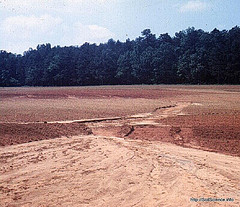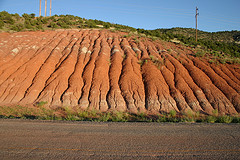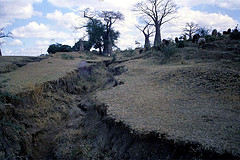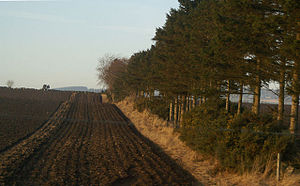Soil erosion means the removal of the movement of the topsoil from one place to another.
- This may be caused by the action of running water or wind.
- When it rains, running water can carry the topsoil to the rivers, lakes or even seas.
- Also when the river flows, it carries with it the soil found along the river bank.
- When the wind blows, it can sweep away the loose topsoil from one place to another.
- The things that cause soil erosion are referred to as the Agents of soil erosion.
- The agents of soil erosion are water and wind.
There are four types of soil erosion:
• Splash erosion
• Sheet erosion
• Rill erosion
• Gully erosion
They are discussed in more detail below:
Splash erosion is usually caused by the action of water hitting the soil when it is raining.
The drops of rain remove the soil particles from the ground as the rain water falls to the ground.
This leaves holes in the ground.
Sheet erosion occurs when the topsoil is carried away uniformly either by wind or water.
Since the soil is washed away uniformly, it is not easy to notice sheet erosion.
It occurs when there is heavy rain or when the wind blows fiercely.
Sheet erosion reduces the depth of soil in a particular area.

Rill erosion leaves behind narrow, shallow and wavy channels.
These channels are known as rills.
The rills are caused when water forms streams to flow through when it is raining.
Rill erosion occurs when the rain is not too heavy and therefore the amount of water flowing is not too much.
The water also flows slowly.

Gully erosion is caused when rainwater forms very sharp and deep channels or valleys.
The deep channels are referred to as gullies.
The gullies are created when water flows very fast and strongly (rapidly) down a slope.
Land damaged by Gulley erosion

Soil erosion depends on:
The amount of erosion in a hilly area on a rainy day would be much more compared to that in a flat area.
Soil erosion also depends on the availability of plants in the area.
A hilly area covered with plants would not have as much erosion as a bare hilly area.
This is because the soil in the area covered with plants is not exposed.
The plants hold the soil tightly in place.
Plants also help in breaking the wind.
They stop the wind from blowing away the soil.

Standard 6
1. Some pupils in primary school planted cypress seeds in a nursery during the morning hours. There was heavy rainfall in the evening of the same day which exposed seeds. To prevent the seeds from being exposed the pupils should have
A. Applied mulch after planting
B. Planted the seeds deeply
C. Fenced around the nursery
D. Avoided planting in the morning
2. Standard VIII pupils noticed that rills had formed on their school garden which had been prepared for planting
A. Contour ploughing. B. Application of mulch
C. Construction of terraces D. Planting of windbreaks
3. Pupils at Mulima Primary School wanted to find out whether planting grass on a slope would reduce soil erosion. They planted grass on one tray and left the other without. They then set up their experiment as shown in the diagrams below.

What error did the pupils make in setting up this experiment?
A. Making the slope of the trays different.
B. Dripping water from the same height.
C. Using only one type of soil in both trays.
D. Planting grass on one tray only.
4. Which one of the following types of soil erosion is most likely to take place without being noticed?
A. Rill B. Gully C. Sheet D. Splash
5. Which one of the soil conservation structures below should be constructed across a deep wide gully to control erosion?
A. Check dam B. Terrace C. Gabion D. Waterway
6. Which one of the following farming activities would lead to soil erosion?
A. Ploughing across the slope B. Ploughing along the slope
C. Growing pasture crops D. Controlling weeds